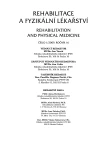Psychosocial Risk Factors in Rehabilitation Patients with Cardiovascular Diseases
Authors:
M. Ištoňová 1; M. Palát 2; K. Kociová 1
Authors‘ workplace:
Prešovská univerzita v Prešove, Fakulta zdravotníctva, Katedra fyzioterapie, Prešov
vedúca katedry PhDr. K. Kociová
1; Slovenská spoločnosť pre vzdelávanie pracovníkov v zdravotníctve SLS, Bratislava
predseda prof. MUDr. L. Badalík, DrSc.
2
Published in:
Rehabil. fyz. Lék., 16, 2009, No. 1, pp. 26-32.
Category:
Original Papers
Overview
With regard to high mortality from ischemic heart disease and to its critical culmination of myocardial infraction in worldwide scale and in addition to somatic risk factors, more attention has recently been paid to psychosocial risk factors. It is proved that many factors of biological, psychological and social character participate in inception, development and course of heart diseases and diseases of vascular system.
In connection with cardiovascular diseases proper attention is devoted especially to depression, anxiety and hostility. In the thesis we analyzed questions of patients’ rehabilitation with myocardial infraction with emphasis on psychosocial factors which – in present rehabilitation process – have got very important function.
In the thesis the questionnaire measuring anxiety – scale by Beck and the questionnaire measuring depression – scale by Zung were used. We focused on diagnostic of component A- type of behaviour: we also concentrated on the time – urgency and free - floating hostility, as risk factors of coronary heart disease – which is in our case myocardial infraction, where we used videoclinical exam by Friedman and Ghandour as a diagnostic method.
Having processed these numerical details we found significant differences between control and experimental group in the following dimensions: time – urgency, free- floating hostility, and total score videoclinical exam, in the scale of anxiety by Beck and in the scale of depressions by Zung.
Key words:
psychosocial risk factors, myocardial infarction, A- type of behaviour, videoclinical exam, time-urgency, free-floating hostility
Sources
1. CNAAN, et al.: Principles of psychosocial rehabilitation. Psychosocial Rehabilitation Journal, 11, 1988, 4, s. 61.
2. FRASURE–SMITH, N., LESPERANCE, F., TALAJIC, M.: Depression following myocardial infarction. Impact on 6 – month survival. Jama, 270, 1993.
3. FRASURE–SMITH, N., LESPERANCE, F., TALAJIC, M.: Depression and 18–month prognosis after myocardial infarction. Circulation, 91, 1995, s. 999-1005.
4. FRIEDMAN, M., GHANDOUR, G.: Medical diagnosis of type A behaviour. Am. Heart J., 126, 1993, 3, s. 607-618.
5. GURSKÝ, K. a kol.: Šport a pohybová aktivita v prevencii a liečbe. 1. vyd., Prešov, Prešovská univerzita v Prešove, 2008. 116 s., ISBN 978-80-8068-789-2.
6. HATALA, R.: Manažment kardiovaskulárnej epidémie – od edukácie a prevencie k špecializovanej akademickej medicíne. In: Zdravie je bohatstvo. Skrátené texty prednášok konferencie. Bratislava [ on line ]. 20. 2. 2007. [ cit 12-08-08 ]. Dostupné na internete: .
7. HEMINGWAY, H., MARMOT, M.: Psychosocial faktors in the aetiology and prognosis of coronary heart disease: systematic review of prospective cohort studies. West J. Med., 171, 1999, s. 342-350.
8. IŠTOŇOVÁ, M., KOCIOVÁ, K., MIKUĽÁKOVÁ, W.: Komplexný prístup pri zostavovaní rehabilitačného programu pacientov po infarkte myokardu. In: MOLISA, 2008, 5. s. 62-66, ISBN 978–80-8068-622-2.
9. KOPP, M.: Psychosocial risk factors, inequality and self – rated morbidity in a changing society. Lecture. Increase in Coronary Heart Disease in the Central and Eastern Europe: Stress and Gender related Factors – NATO Advanced Research Workshop, May 20 – 24, 2000, Budapešť.
10. KRISTENSON, M.: Chronic stress and the rising CHD in Eastern Europe: Results from a comparative study od Sweden and Lithuania. Lecture. Increase in Coronary Heart Disease in the Central and Eastern Europe: Stress and Gender related Factors – NATO Advanced Research Workshop, May 20 – 24, 2000, Budapešť.
11. LACHAR, B.: Coronary-prone behavior. Type A behavior revisited. Tex Heart Inst. J., 20, 1993. s. 43-151.
12. MAYOU, R.: Rehabilitation after heart attack. BMJ, 313, 1996, s. 1498-1499.
13. NIEDERLE, P.: Je psychosocialní problematika u srdečních onemocnění aktuální? Kapitoly z kardiologie. [ on line ] 2001, sv. 2, č. 3, [ cit 30-08-03 ], Dostupné na internete: http://www kapitoly.kapitoly.cz/clanek.php?num= 16.
14. PALÁT, M.: Behaviorizmus, behaviorálna medicína, behaviorálna terapia. In: EuroRehab., 12, 2002, 3, s. 131-132, ISSN 1210-0366.
15. SELKO, D., DUBAYOVÁ, T.: Typ D a riziko kardiovaskulárnych ochorení v „zdravej populácii“ In: Psychológia zdravia - rok 1? Bratislava 2006. [ on line ]. [ cit 12-10-08 ]. Dostupné na internete: http://www.psychologia.sav.sk/sps/pz.pdf.
16. SKORODENSKÝ, M.: Psychologické rizikové faktory ischemickej choroby srdca. Bratislava, VEDA, 1991. 196 s., ISBN 80-224-0335-0.
17. SKORODENSKÝ, M. et al.: Psychological, medical, and bio-behavioral factors in coronary heart disease. Studia Psychologica, 49, 2007, 4, s. 321-333.
18. SKORODENSKÝ, M., TAKÁČ, P.: Behaviorálna medicína v historickom kontexte rozvoja biomedicínskych vied. In: EuroRehab., 12, 2002, 3. s. 132-138, ISSN 1210-0366.
19. STANČÁK, A.: Klinická psychodiagnostika dospelých. Nové zámky, PSYCHOPROF, 1996. 351 s.
20. ŠIMON, J. a kol.: Epidemiologie a prevence ischemické choroby srdeční. 1.vyd., Praha, Grada Publishing, spol. s.r.o., 2001, 264 s., ISBN 80-247-0085-9.
21. ŠKODOVÁ, Z., SKORODENSKÝ, M.: Afektívne charakteristiky pacientov trpiacich srdcovocievnymi ochoreniami. In: EuroRehab., 12, 2002, č. 3. s. 156-159, ISSN 1210-0366.
22. ŠPINAR, J. VITOVEC, J. a kol.: Ischemická choroba srdeční. 1. vyd., Praha, Grada Publishing, spol. s.r.o., 2003, 364 s., ISBN 80-247-0500-1.
23. TAKÁČ, P.: Vzťah rehabilitácie a behaviorálnej medicíny. In: EuroRehab., 12, 2002, 3, s. 139-145, ISSN 1210-0366.
24. TAKÁČ, P., ONDEČKOVÁ, M., SKORODENSKÝ, M., BABINČÁK, P.: Analýza niektorých psychosociálnych faktorov v rehabilitácii po infarkte myokardu. In: EuroRehab., 14, 2004, 2, s. 60-67, ISSN 1210-0366.
25. WILLIAMS, R. B.: Neurology, cellular and molecular biology, and psychosomatic medicine. Psychosom. Med., 56, 1994, s. 308-315.
Labels
Physiotherapist, university degree Rehabilitation Sports medicineArticle was published in
Rehabilitation and Physical Medicine

2009 Issue 1
Most read in this issue
- Evaluating Hand Motor Performance in a Chronic Stage after Brain Stroke – Finger Tapping Test
- Vertebrobasilar Complications in Manipulation Treatment of Cervical Spine
- What is the Way of Vojta’s Method Functioning
- Comparison of Efficient Mud Bath Tub and Mud Wraps in an Alternative Way
